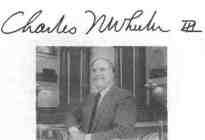
POLITICS
Charles N. Wheeler III is director of the Public Affairs Reporting program at the University of Illinois at Springfield.

The promises George Ryan made during the campaign carry a price
by Charles N. Wheeler III
During his successful campaign for the Executive Mansion last year, Gov. George H. Ryan laid out ambitious plans to lead Illinois into the 21st century, promising advances in education, workforce training, transportation, law enforcement and a host of other government activities, all the while holding the line on taxes.
Democratic opponent, then-U.S. Rep. Glenn Poshard, argued the Republican was promising much more than the state's fiscal condition would allow him to deliver. But Ryan insisted the state's robust economy would generate enough revenue to cover the $1 billion or so his proposals were expected to cost.
Most voters agreed — or at least weren't too concerned about a possible shortfall — and so now Ryan must convert his campaign rhetoric into dollars and cents as he prepares the fiscal year 2000 state budget that he is to unveil in a few weeks.
The task might not be as difficult as Poshard expected, however, thanks to several strokes of good fortune that should provide Ryan some cushion.
State revenues have been coming in stronger than anticipated this fiscal year, and are expected to grow again next year. Budget-makers initially pegged revenue growth at 7 percent for fiscal year 1999, but for the first six months, the rate was 8.9 percent.
Also, Attorney General Jim Ryan's decision to join the multistate tobacco
|
During his gubernatorial campaign, Ryan insisted the state's robust economy would generate enough revenue to cover the $1 billion or so his proposals were expected to cost. Most voters agreed. |
settlement could bring Illinois as much as $9.1 billion over the next 25 years, with a first installment of $112 million arriving sometime in fiscal year 2000.
Meanwhile, the governor's pledge to scour up more federal dollars for Illinois looks much more doable after the amazing rise of U.S. House Speaker J. Dennis Hastert, who was on the inaugural platform. "We're going to be in Washington, D.C., to pick your pocket on occasion," Ryan told the Yorkville Republican, a freshman in the Illinois House during Ryan's speakership.
The extra revenue — and a powerful friend in Congress — will make it easier for the governor to make good on his campaign promises. Among the major commitments he'll be expected to meet in his fiscal year 2000 spending blueprint:
• 51 percent of new general funds revenue for education and workforce development. How much the budget proposes depends, of course, on how much new money is expected to come in. In the campaign, Ryan's number-crunchers estimated the pledge would amount to $530 million, based on revenue growth of slightly more than $1 billion. If growth is less, as some forecasters now expect, Ryan's education outlay could be less.
Some increases in school spending are mandated already, such as a $73 million boost in retirement contributions and an additional $42 million to meet the per-pupil funding guarantees enacted two years ago.
Ryan also pledged to use the new money to hire more teachers, beef up reading instruction, boost spending for early childhood and literacy programs and upgrade technology. In addition, he proposed $ 1,000 career vouchers for high school graduates seeking training for a vocational career, at a projected fiscal year 2000 cost of $50 million. He also wants an income tax credit of up to $500 for families with children attending private schools to help pay for tuition and books. Former Gov. Jim Edgar vetoed a similar measure, saying it would divert some $100 million from public schools, but Ryan sees the credit as tax relief for families.
• $200 million for roads. Flatly opposed to any increase in the state's gasoline tax, Ryan instead offered a plan relying on borrowing and more federal aid. But his undisputed top priority is the "Hillside Strangler," a west suburban stretch in which two three-lane interstates and a major road merge into one lane feeding the Eisenhower Expressway to Chicago. A Ryan billboard overlooking the bottleneck promised voters that he'd untangle the mess; when the plans are ready, Hastert could be a major help in getting the money to pay for the work.
• $156 million for crime prevention
42 February 1999 Illinois Issues
and prisons, about two-thirds of it to meet added expenses of a growing inmate population. Ryan also promised more high-tech equipment to manage prisoners and juvenile justice reforms, and he pledged to double the number of parole officers and to boost community policing efforts.
But his plan to impose harsher
sentences for the use of a gun in
committing a crime won't cost
anything more until wrongdoers
begin serving extended terms.
• $23 million for economic
development programs, including
additional spending for tourism,
export promotion, trade shows and
marketing efforts.
• $18 million for community-based
substance abuse treatment, expanded
|
With the state's fiscal condition in its best shape in memory, Ryan's biggest challenge may be holding the line against a spending orgy fueled by the state's record balances. |
health insurance for children of the working poor, infant mortality prevention, women's health programs and a variety of other social services.
• Additional bond sales for capital projects, including $1 billion more for school construction and $160 million for open space preservation.
With the state's fiscal condition in its best shape in memory, Ryan's biggest challenge may be holding the line against a spending orgy fueled by the state's record balances.
"When you don't have money, it's pretty easy to say no," mused Edgar, whose early years as governor were awash in red ink. "But when you have some money, then people want to start spending it, and they always want to spend more than you have."
Illinois Issues February 1999 43